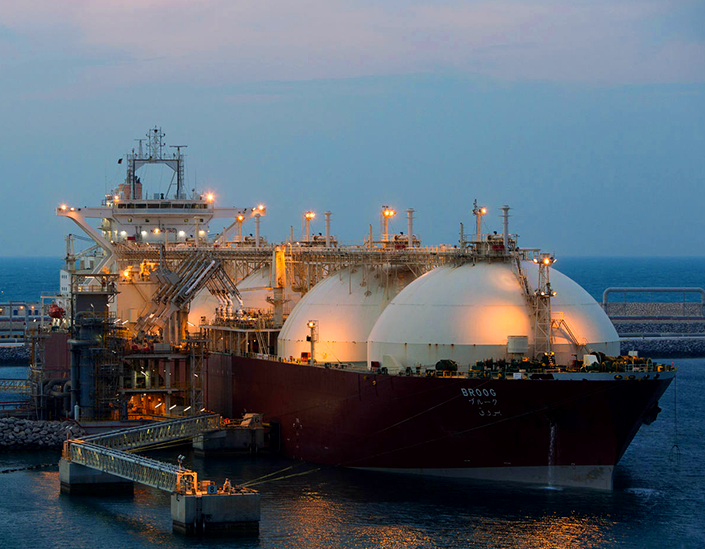Germany, here is the first floating regasification terminal

In Germany the first floating regasification terminal is inaugurated today, which according to the Ministry of Economy could lead to overcapacity. The article by Pierluigi Mennitti from Berlin
The tools for the inauguration party are all there, including the bottle of Sekt, the German sparkling wine, which perhaps will be uncorked directly by the chancellor. There is also Olaf Scholz, in fact, bundled up to defend himself from temperatures well below zero on the port pier of Wilhelmshaven for the absolute premiere of a LNG terminal in Germany.
To be celebrated above all is the construction in record time of the infrastructure built by Uniper, the company that the government had to state in a hurry to save it from the precipice of bankruptcy which it had approached with the end of Russian gas supplies. This time everything went smoothly and it took an ecological minister, the head of the Economy Robert Habeck, to speed up procedures and authorizations, above all smoothing out those obstacles that had so far allowed environmentalist movements to slow down every energy plant. Even Habeck smiles satisfied, regardless of the controversies that aggressive groups such as Deutsche Umwelthilfe (literally German Environmental Aid) have spilled on him: such as the fact that the terminal is too close to the Wadden Sea world heritage site, causing fears of damage to the ecosystem.
Habeck can shrug, looking at the polls that reward his party, unique among those in the majority, precisely for its pragmatic conduct during the energy crisis. A few months have passed since the government launched a massive investment plan on regasification terminals, and the first plant is ready. The second, in the Baltic Lubmin, will follow suit.
Wilhelmshaven is a small port at the mouth of the Elbe on the North Sea in Germany's northernmost state, Schleswig-Holstein, not far from Scholz's home town of Hamburg. From here, according to Uniper's plans, natural gas will be injected into the German network for the first time on Thursday 22 December. On Thursday, the 300-metre-long FSRU vessel Höegh Esperanza positioned itself in the sea space off Wilhelmshaven, ready to convert 165,000 cubic meters of liquefied natural gas – enough to supply up to 80,000 households for a year.
In future, the terminal will have to inject at least five billion cubic meters of LNG per year into the German gas network, equivalent to 6% of Germany's gas demand, thus replacing almost 11% of gas imports from Russia. The first pure LNG tanker is expected to arrive at the Hooksiel pier in Friesland in mid-January.
Wilhelmshaven is, as written several times in recent months, only the first step in the efforts of the German government in the field of LNG. Two other floating regasification terminals are in the pipeline, that of Brunsbüttel, also in Schleswig-Holstein, and of Lubmin, near Greifswald. The latter location is known for being the arrival terminal of the now dry pipes of Nord Stream 1 and 2, now wrecks in memory of the energy Ostpolitik that was.
And in recent times, counting has almost been lost on how many regasification terminals will sprout like mushrooms along the two northern coasts of Germany, on the North Sea and on the Baltic. Between public, semi-public and private initiatives, as many as thirteen could see the light of day by 2026. Perhaps too many, so much so that the Ministry of Economy now foresees "significant overcapacity in the construction of all liquefied natural gas terminals in Germany" .
As for the planned floating terminals, the so-called floating storage and regasification units, Habeck's ministry explains, the "capacity of existing FSRUs and land-based terminals would exceed the level of gas import volumes from Russia in 2021". The news leaked thanks to the digital media service "Table Media", which quoted the preliminary report of a confidential preparatory report by the ministry for a meeting at the Chancellery. According to the report, ten floating terminals planned in the North Sea and the Baltic Sea are in fact mentioned, six of which with state participation.
These floating terminals alone would have a capacity of 53-67 billion cubic meters of gas per year from 2024. In addition, three land-based terminals will be built by 2026, also having a capacity of up to 50 billion meters gas cubes. By way of comparison, only 54 billion cubic meters were imported from Russia to Germany via pipeline in 2021. At the same time, overcapacities are exacerbated by the fact that other EU states also import significantly more liquefied gas and, at the same time, demand in Germany will decline significantly by 2030 as the energy transition process advances.
This is a machine translation from Italian language of a post published on Start Magazine at the URL https://www.startmag.it/energia/germania-ecco-il-primo-rigassificatore-galleggiante/ on Sat, 17 Dec 2022 06:23:17 +0000.
